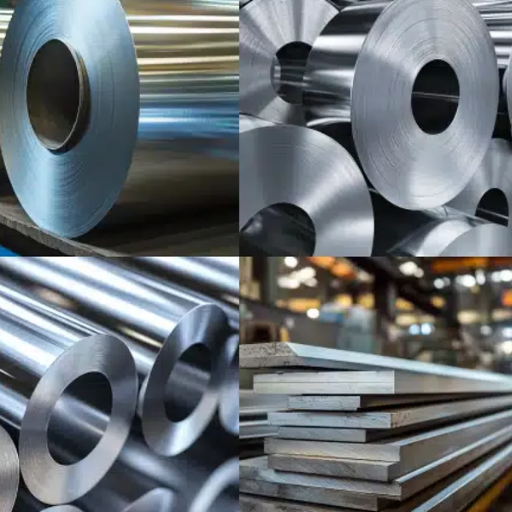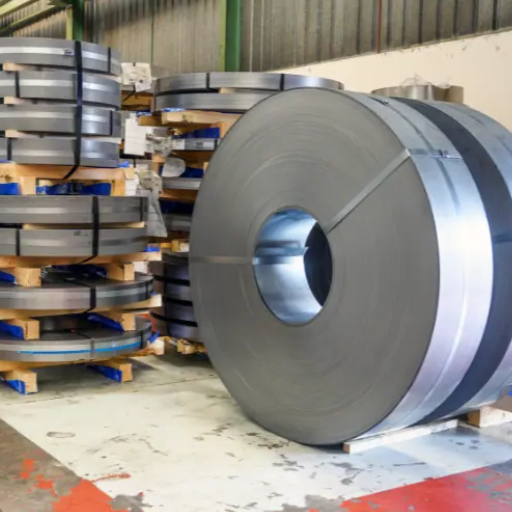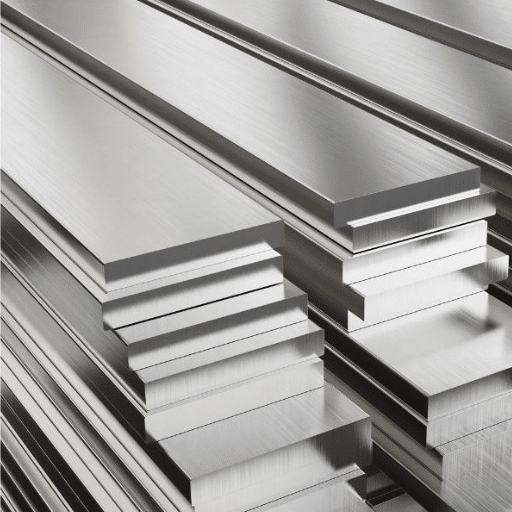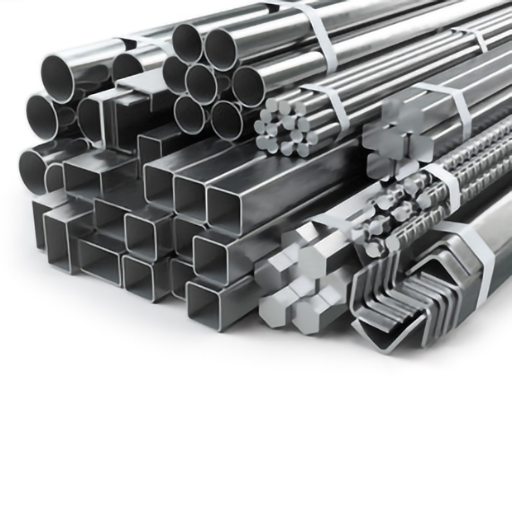From the construction and transportation industries to household items and medical equipment, stainless steel is one of the most useful and common materials. Stainless steel is used in applications that require great strength and durability due to its remarkable ability to resist corrosion. In this guide, we’ll examine what makes stainless steel unique by looking at its structure, performance, and applications. We will cover the composition and types of stainless steel, the production processes, and how these properties make the material useful. No matter if you are an engineer, an industry professional, or simply someone interested in learning more about this remarkable material, this guide will explain why stainless steel is essential in modern life.
What are the Chemical Properties of Stainless Steel?

The combination of iron and a minimum 10.5% chromium is required in the formation of stainless steel. This chromium is tasked with offering corrosion resistance to stainless steel. Properties like strength and durability can be further altered with the inclusion of elements like nickel, molybdenum, manganese, and carbon. Stainless durability also makes it one of the most suitable materials to be used in ever-evolving environments. Oxygen interacts with chromium, and during the reaction, a thin protective oxide layer is created at the surface, which prevents corrosion and rust.
Stainless steel has chemical properties such as:
- Chromium oxide protective layer contributes to strong corrosion resistance.
- Strength and durability are excellent; further improved with additions of nickel or molybdenum.
- High capability of resisting oxidation at elevated temperatures makes it useful in extreme environments.
- Inertness towards numerous substances enables use in food, chemicals as well as medical applications.
How Chromium Enhances Corrosion Resistance
With an inclusion of 10.5% chromium, stainless steel can offer further protection against corrosion. The chromium will interact with oxygen and produce Cr2O3, a stabilized chromium oxide, which is a protective layer. This layer will ensure to protect the rest of the material is protected from being corroded by oxidation. Moreover this layer is capable of renewal, meaning even if it is damaged, it can mend itself aided with oxygen. In the marine and chemical industries, 16-18% chromium is favored in alloys due to their austenitic properties and oxidation.
The Role of Nickel in Stainless Steel’s Durability
The addition of nickel enhances the ability of stainless steel to withstand corrosion and increases its corrosion resistance of stainless steel. Because nickel stabilizes the austenitic structure, it helps to retain the steel’s ductility and toughness at cryogenic temperatures. Grades like 304 and 316 stainless steels contain varying percentages of nickel, which usually range from 8-12%. Nickel also increases resistance to oxidation and pitting corrosion in more chlorides and aggressive chemical environments.
As an illustration, Type 304 stainless steel has a composition of 8-10.5% nickel, making it highly resistant to corrosion for general applications. Type 316, on the other hand, has 10-14% nickel in addition to 2-3% molybdenum, making it highly suitable for marine environments and applications that experience high chloride exposure. In general, nickel makes sure stainless steels maintain their useful mechanical properties alongside their anticorrosive properties, which are crucial for high-performance alloys.
How do Mechanical Properties Influence the Use of Stainless Steel?

Such mechanical properties greatly impact the appropriateness of stainless steel for different uses. Factors like tensile strength, ductility, toughness, and in particular, the ability to resist deformation and endure stressing and harsh environments ensure the usefulness of stainless steel. An example is in construction and infrastructural development, where stainless steel with high tensile strength is best suited. On the other part of the ductility, the aerospace and automotive manufacturing industry prefer materials with high toughness and ductility, making them flexible. With all the aforementioned demanding applications, stainless steel’s mechanical properties allow it to withstand wear and quite literally put it through the test of durability.
Assessing the High Strength of Stainless Steel
According to my research, the best characteristics of stainless steel are its excellent strength and high tensile strength, as well as its ability to deform under stress. This is attributed to the alloy composition of the metal, which includes chromium, nickel, and sometimes molybdenum, as these elements are added to increase its structural stability. Furthermore, its strength combined with its ductility makes it versatile enough for construction, aerospace, and automotive manufacturing. Unlike other materials, stainless steel is durable yet resilient under extreme conditions, which is why engineers and designers around the world appreciate it.
The Importance of Resistance to Corrosion in Various Applications
Due to the ability to withstand harsh conditions, corrosion resistance is critical in the lifespan and functionality of materials in many industries. For instance, stainless steel’s chromium content, which passes an oxide layer over the surface, blocking further oxidation and corrosion, strengthens stainless steel’s resistance to corrosion.
Key Technical Parameters Enhancing Corrosion Resistance:
- Chromium Content: Usually 10.5% to 30%, is important in stainless steel because it provides an is oxide used for protection.
- Nickel Content: 8-12% in austenitic stainless steel is known to improve surface corrosion resistance in case of acid or chlorine rich environment.
- Molybdenum Content (if applicable): A maximum of 3% improves resistance to pitting and crevice corrosion, especially in marine applications.
- Surface Finish: Polished or passivated increases safety crevices for the beginning of corrosion. Using such surfaces ensures reduced spaces where corrosion could take place.
- Temperature Tolerance: Maintains corrosion resistance up to 1200-1300°F (649-704°C). The unit increases it’s usefulness in high-grade usages.
With these qualities, stainless steel is critical in marine engineering, chemical processing, construction and industries constantly exposed to moisture or corrosive agents. Proper selection of these criteria improves corrosion resistance while minimizing maintenance and replacement expenditures.
What are the Different Grades of Stainless Steel and Their Applications?

Stainless steel has several characteristics that subdivide it into grades, each with a composition meant for particular applications. Let’s have a look at the main grades of Stainless steel:
- Austenitic Stainless Steel (Grades 304 and 316)
- Grade 304: Perhaps best known for its versatility, able to withstand several forms of corrosion, therefore, it is used in kitchenware, food processing equipment, architectural applications, etc.
- Grade 316: Known for its use in Marine, Pharmaceutical, and Chemical applications as it contains Molybdenum, which helps it withstand Pitting and Chloride environments.
- Ferritic Stainless Steel (Grades 409 and 430)
- Grade 409: Helps withstand exhaust gases while still being low-priced. This characteristic makes it valuable for use in Automotive Exhaust Systems.
- Grade 430: Famous for good resistance to corrosion and an appealing finish. because of this, it is very popular for use in decorative Kitchen appliances, those lunch boxes that you take to school, and cutlery.
- Martensitic Stainless Steel (Grades 410 and 420)
- Grade 410: Has High Resistance to Wear and great sturdiness, traits that make this used for Cutlery, Valves, and Fasteners.
- Grade 420: Famous for its high degree of hardness coupled with the ability to polish it is often used in surgical knives and utensils termed Surgical Instruments.
- Duplex Stainless Steel
- Surgical Steel, as it is sometimes called, contains features new austenitic and ferritic stainless steel merged, offering high resilience to corrosion while greatly enhancing their strength. This is highly valued for use with Oil, Gas, Chemical plants, and Structural Components.
Appropriate selection of grade enables industries to improve performance and durability relative to specific operating conditions.
Exploring 304 Stainless Steel and Its Uses
304 stainless steel is one of the most commonly used grades of stainless steel. I can tell you that its a unique combination of properties that makes it incredibly versatile. Since it’s made of chromium and nickel, it has exceptional corrosion resistance even in very harsh environments. This makes it ideal for use in kitchen equipment, food processing, and pharmaceutical equipment where cleanliness and durability are very critical.
It also has good strength, and it’s very easy to fabricate. Moreover, 304 stainless steel is readily welded and polished, making it very popular in the construction and automotive industry, as well as in household products. In addition, the ability to resist oxidation and withstand a wide range of temperatures further expands its use in chemical tanks and piping systems. All in all, 304 stainless steel is widely used because it provides the best value across diverse industries.
Understanding 316 Stainless for Marine Environments
316 stainless steel is at the zenith of its class because of its amazing resistance to corrosion, especially in marine and chloride-rich environments. The addition of molybdenum is what gives 316 such enhanced resistance by pitting and crevice corrosion due to saltwater exposure.
Here’s a sketch of important properties of 316 stainless steel about marine environment use:
- Chemical Composition: 16-18% Chromium, 10-14% Nickel, 2-3% Molybdenum 2% Manganese (max).
- Corrosion Resistance: Great resistance to chlorides and attack from the marine environment.
- Yield Strength: Approximately 30000 psi (207 MPa).
- Tensile Strength: Approximately 75000 psi (515 MPa).
- Maximum Operating Temperature: About 1500 °F (815 °C) when used continuously sustained
- Weldability: Most welding techniques can use it without the need for post-weld annealing.
- Formability: Can be constructed into many different shapes for certain applications with low difficulty.
Due to the above properties, 316 stainless steel marine hardware, boat fittings, underwater pipelines, coastal construction materials are the ideal choice. Reliable and durable performance is further ensured by extended service life, withstanding the worst marine environments.
The Versatility of Duplex Stainless Steel
The unique microstructure of duplex stainless steel, consisting of austenite and ferrite in equal parts, is renowned for its high strength and superb corrosion resistance, making it ideal for demanding applications. Its mechanical properties and durability surpass more conventional stainless steel grades.
Key Properties:
- Corrosion resistance: Duplex stainless steels demonstrate exceptional resistance to pitting, crevice corrosion, and stress corrosion cracking in chloride-rich waters, like seawater and chemical processing.
- High strength: It has almost double the tensile strength of 304 and 316 austenitic stainless steels, enabling the utilization of thinner and lighter materials.
- Typical tensile strength: 600 to 800 MPa
- Yield strength: About 450-600 MPa
- Weldability: Although good weldability is noted, proper care must be taken to eliminate brittleness in heat-affected zones.
- Thermal conductivity: Better than austenitic grades, with lower thermal expansion and thus lesser thermal cycle fatigue.
- Toughness: Reasonably retains toughness at sub-zero temperatures, permissible for both cryogenic and high-temperature environments.
- Cost-effective: Its high strength means less material is required, lowering costs while maintaining performance.
Uses of Duplex Stainless Steel
Due to its adaptability, duplex stainless steel is used in several sectors of industry:
- Chemical Processing: Works well for storage tanks, heat exchangers, and reactors containing corrosive chemicals.
- Construction: Employed for structural supports, rebar and bridges because of its robust stance and durability.
- Marine Applications: Applied within the offshore industry and in shipbuilding along with desalination plants which face excessive seawater.
- Pulp and Paper Industry: Selected often for bleach washers, digesters and storage tanks subjected to harsh chemicals.
- Oil and Gas Industry: Permits usage in tanks, pressure vessels and pipelines because of its strength to withstand sour gas environments.
A variety of duplex stainless steels, like 2205 and 2507 are cost-effective and low-maintenance, proving reliability over time, which makes them favorable for critical industrial applications.
How Do Alloying Elements Affect Stainless Steel Properties?

The properties of stainless steel are impacted by alloying elements to its strength, durability, and resistance to corrosion. To illustrate, chromium is one of the key components that restrains corrosion due to its passive oxide layer. Nickel assists in augmenting the ductility and toughness, thereby increasing the usability of stainless steel in extreme temperatures. Molybdenum enhances pitting and crevice corrosion resistance, which is important in environments rich in chlorides. Other elements like nitrogen increase the strength and resistance to corrosion, while manganese helps in enhancing the formability. The combination and careful balancing of these elements enable engineers to customize stainless steel for various applications designed for specific performance requirements in different industries.
The Impact of Molybdenum on Corrosion Resistance
In stainless steel’s resistance to corrosion—especially in marine applications—molybdenum plays an industrial role due to chlorides and other chemicals. Molybdenum bolsters its defenses against pitting and crevice corrosion, which durable materials face in the chemical processing and desalination industrial sectors and marine construction.
Technical Data of Molybdenum in the Use of Stainless Steel:
- Pitting Resistance Equivalent Number (PREN): Molybdenum affects the PREN value, augmentatively to be calculated with
PREN = %Cr + 3.3(%Mo) + 16(%N).
As with the other resistance measures, higher PREN values mean lesser localized corrosion.
- Typical Molybdenum Content: Grades like 316 and 317 stainless steel contain approximately 2–3% of molybdenum. For extreme corrosion resistance, duplex stainless steels sometimes draw molybdenum content up to 7%.
- Chloride Resistance: Molybdenum has enormous value in preserving alloys with seamless flow of chloride ion concentration when compared to non enriched alloys without these elements. Structurally important for preservation under implementing environments.
For greater results in the performance and life of the steel, a reasonable amount of molybdenum is added. These traits mark steel as favorable for high resistant industries.
The Role of Carbon in Different Stainless Steel Grades
Without a doubt, carbon affects the properties of different types of stainless steel. I have always felt that changing the carbon content moderately balances the strength, hardness, and corrosion resistance. For example, the low-carbon grades 304L and 316L are made to contain carbide precipitation because they are more weldable and corrosion resistant in welded applications. While high carbon grades such as 420 or 440C are preferred in the fields because they contain superior hardness and wear resistance, which compromise corrosion resistance. It is clear to see that carbon in steel varies case by case depending on the application’s needs and the operating conditions of the steel.
Why is Stainless Steel Widely Used Across Industries?

Improved stainless steel has positively influenced many fields due to its combination of standout properties. Its corrosion resistance is second to none, particularly regarding moisture, chemicals, and extreme temperatures. Along with durability and strength that ensures a long-lasting service life, ease in shaping, machining, welding, and fabrication make it versatile for various applications. Moreover, increased value in the construction, automotive, medical, and food processing industries comes from being low-maintenance, hygenic, and aesthetically appealing.
Examining the Use of Stainless Steel in Construction
Steel makes an important contribution to construction owing to its remarkable properties. From my research, I understand that the corrosion resistance of stainless steel makes it ideal for outdoor constructions and places subjected to varying climatic conditions. Furthermore, stainless steel’s strength and durability ensure that buildings are secure and endure over time. Its versatility allows it to be employed both as structural steel and as decorative steel. In addition, stainless steel features low maintenance, making it environmentally friendly, as it is 100% recyclable, which complements the shifting focus on sustainable construction.
Applications of Stainless Steel in the Automotive Industry
The resistance to corrosion, sturdiness, and strength make stainless steel exceptionally useful in the automotive field. It helps maintain vehicles at the required safety, longevity, and aesthetic standards. Stainless steel has various applications in the automotive industry, including:
- Exhaust Systems: For exhaust components, stainless steel is preferred due to its high temperature tolerance and corrosion resistance from exhaust gases. Economically, grades 409 and 439 are used, which provide adequate corrosion resistance and heat resistance.
- Structural Components: With the need for more security, stainless steels are used in the chassis and frames of the vehicle. These use more advanced grades like 304 and 31,6, which have better mechanical properties, which are ideal for structural applications.
- Decorative and Trim Elements: Manufacturers add external features like trims and even grills made from stainless steel because of its decorative nature and ability to resist tarnishing/rusting.
- Fuel Tanks: Stainless steel fuel tanks are the best option because they are extremely durable and do not contaminate the fuel with rust.
- Energy Storage and Electric Vehicles: Hydrogen storage is compatible with stainless steel, and due to its cryogenic temperature resilience, it becomes crucial for hydrogen fuel cell vehicles. Using it makes automotive production more eco-friendly as well, due to the ease of recycling it.
The inclusion of stainless steel in automobile components allows manufacturers to enhance performance, safety, and sustainability in their designs, which undoubtedly meets the needs of contemporary industry.
The Significance of Stainless Steel in Medical Equipment
Due to high resistance against corrosion, ease of sterilization, and durability, stainless steel is important in the production of medical equipment. Its strength ensures surgical instruments and even hospital beds get long-lasting performance. Stainless steel performs hygienic essentials in keeping rust and stains under control, which is critical in healthcare. The alloy is also resistant to a broad range of infections because it can be cleaned and sterilized with great efficiency. There is so much range and adaptability in its use that these qualities make it safe and reliable for both medical professionals and patients.
References
- Stainless Steel Characteristics & Properties – Eagle Tube
- Stainless Steel Properties, Grades and Applications – Alroys
- Stainless Steel: Characteristics, Uses and Problems – GSA
Frequently Asked Questions (FAQ)
Q: What are the key properties of stainless steel?
A: The key properties of stainless steel include its resistance to corrosion, high strength, and durability. Stainless steel is also known for its aesthetic appeal and ability to withstand extreme temperatures, making it a versatile material for various applications.
Q: What is the chemical composition of stainless steel?
A: The chemical composition of stainless steel typically includes a minimum of 10.5% chromium, which makes it resistant to corrosion. It may also contain varying amounts of other elements such as nickel, molybdenum, and carbon, depending on the type of stainless steel.
Q: When was stainless steel invented?
A: Stainless steel was invented in the early 20th century. The term “stainless steel” was first used to describe this rust-resistant alloy in the 1920s, marking its growing importance in industrial applications.
Q: What are the different types of stainless steel?
A: The main types of stainless steel include austenitic, ferritic, and martensitic stainless steels. Austenitic stainless steel is highly corrosion-resistant and non-magnetic, ferritic stainless steel has magnetic properties and is often used in automotive applications, while martensitic stainless steel is known for its hardness and strength.
Q: How does the chromium content affect stainless steel?
A: Chromium content is crucial in stainless steel as it forms a passive layer of chromium oxide on the steel surface, which prevents oxidation and corrosion. This layer is what makes stainless steel superior to other types of steel like mild steel or carbon steel.
Q: What is austenitic stainless steel, and where is it used?
A: Austenitic stainless steel is a type of stainless steel known for its excellent corrosion resistance and formability. It is commonly used in kitchen appliances, chemical industries, and architectural applications due to its aesthetic finishes and durability.
Q: Why is stainless steel referred to as “rustless steel”?
A: Stainless steel is often called “rustless steel” because of its resistance to rust and corrosion. This property is primarily due to the presence of chromium, which forms a protective layer on the metal surface.
Q: What are the magnetic properties of ferritic stainless steel?
A: Ferritic stainless steel is magnetic due to its body-centered cubic crystal structure. Unlike austenitic stainless steels, ferritic types contain little or no nickel, which contributes to their magnetic properties.
Q: How does stainless steel composition influence its applications?
A: The composition of stainless steel determines its suitability for various applications. For example, type 304 stainless steel, part of the austenitic family, is commonly used for stainless steel products due to its excellent corrosion resistance and formability, making it ideal for kitchenware and medical equipment.
Q: What makes stainless steel superior to other types of steel?
A: Stainless steel is superior to other types of steel due to its unique combination of strength, durability, and resistance to corrosion. The alloying element in stainless steel, primarily chromium, provides a protective layer that enhances its resistance and strength, making it a preferred choice for many industrial and consumer applications.







